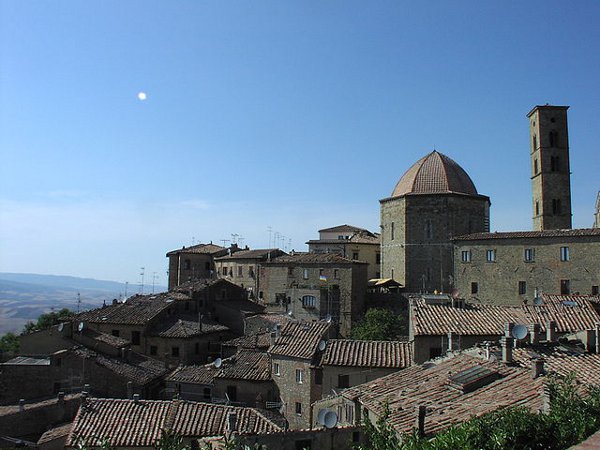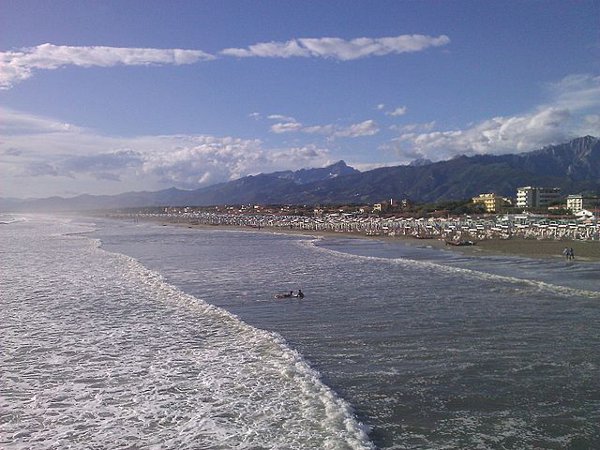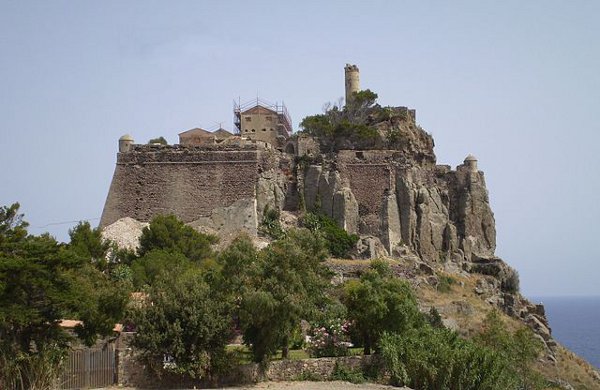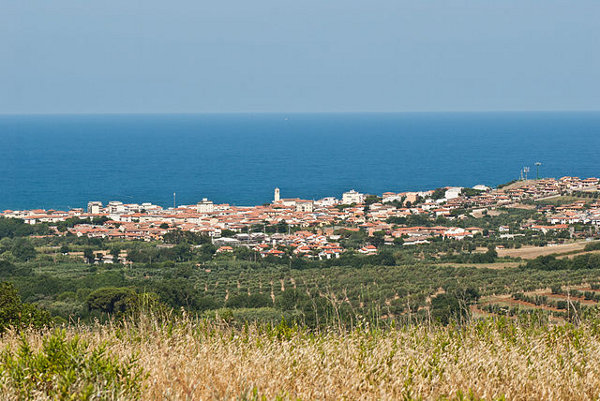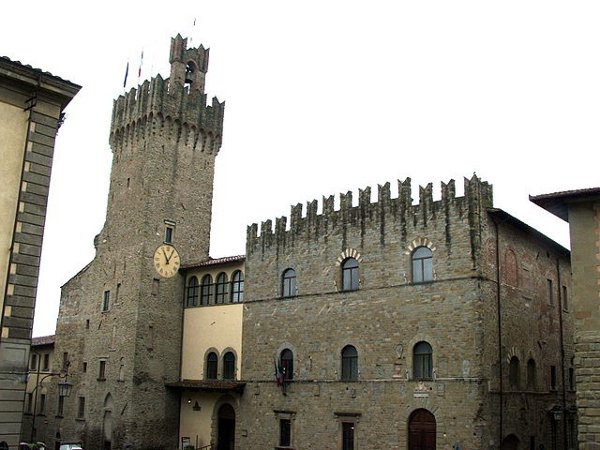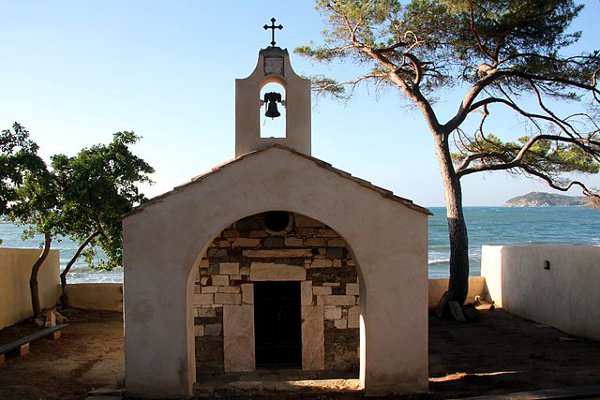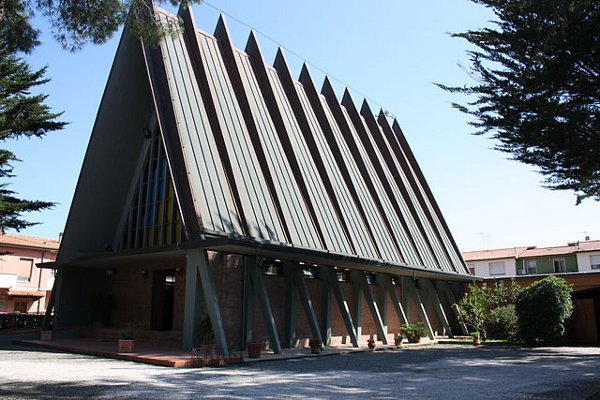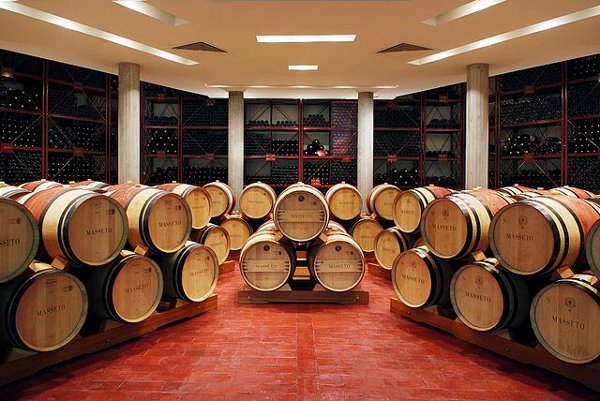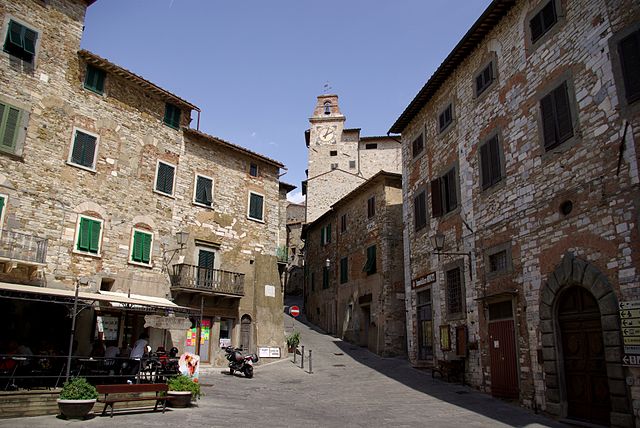It is said that Bibbona was one of the strongest castles in the Maremma, surrounded by turreted walls and defended by a deep ditch. Still obvious is its size of inhabited fortress, built on a low hill.
So it appears entering the maze of narrow medieval layout and building types in which they emerge from different eras and the church of San Ilario eleventh century.
Also evident links with the agriculture of a castle in which, according to a statute of 1400, the head of the family were expected to plant an olive tree every year at least and two fruit trees and also to make the garden.
Just outside the entrance to the castle one of the glories of Bibbona: the beautiful Renaissance church Santa Maria della Pieta, built at the end of the 400 project of Vittorio Ghiberti, Lorenzo's son.
Church of St. Hilary
On the front there is a door architrave finished at the top. Next to the entrance there is a memorial plaque. On the sides are mullioned windows and faux wood. The bell tower stands leaning against the right side. The Church is bordered on the left and right with Via Roma Via Vittorio Veneto.
Palace Gardini
The façade is finished with plaster, and two rows of windows framed in a frame of smooth stone, the same that surrounds the door and on which there is the coat of arms with a tower in the field.
Comune Vecchio
The building has been the seat of legal and later played the role of common
Church St. Joseph
On the facade of this church opens the portal of entry above which there is a plate with a coat of arms and a small rose window, and on the side there are traces of openings now walled up.
Oratory of S. Niccolò
The entrance gate to the seeds side pillars and the window above does not presentente in other churches of the place.
Church of Santa Maria della Pietà
The articulation of architectural and decorative is shown by the main facade, which is characterized by the presence of a simple rose window. Then this Church has a small bell tower.
PERIOD ETRUSCO
The first Etruscan Villanovan settlements that developed in Tuscany between the X and IIX sec. BC have been brought to light in part on the territory of Bibbona.
Many finds from the tombs are above the Etruscans in fact being very religious and gave importance to the death to the passage of the afterlife.
To this made the graves of their real homes, taking our place all the objects belonging to the deceased which could be useful in later life. Due to the richness of the finds, we can say that in the sixth seventh century. the Etruscans came into contact with Greek civilization. Proof of this are the graves of warrior princes dating from the Orientalizing period. The monks and precious objects found in the tombs testify to the skill of the Etruscans in the processing of various metals including gold. In the area, the activities involving gold and steel industry developed in Populonia, where the necropolis was active until the first century. BC when the whole territory was conquered by the Romans.
On the rock of reddish tuff, shelly, very compact, Tertiary origin, was born Bibbona, located at 80 m. above sea level, south of the river Cecina, 7 km from the coast. The name itself suggests, after several transformations, its Etruscan origin: VIPI, VIVIPI, VIPINA, VIPUNA, Vibona, BIBONA.
The birth of this small village probably dates back to the eighth century. BC (Etruscan Villanovan period), as well as those of Montescudaio and Casale, consisting of huts, whose inhabitants lived hunting, cultivating and nurturing, as evidenced by the discovery of a large quantity of tools and small bronzes found in a votive deposit.
Meanwhile in the area, the village of Velhatri (Volterra) became more and more important due to the development of agricultural activities-craft and trade, with whom arrived from the coast Eastern influences (Greek).
From the eighth to the sixth century. BC, about the archaeological finds such as jewelry, luxury items for banquets, weapons, bronze axes, belonged to the so-called "Principles warriors", it is called oriental period, as in the area worked to order some Greek artists, which were then imitated by the locals.
With the development of Volterra, there was also the birth of aristocratic families who had control of the territory as they moved into the villages and some members became "Heads-village" or "Principles warriors", as they began to control both the economy that the defensive organization.
The Principles were distinguished by the people because they had the possession of weapons and death were buried in monumental tombs, accompanied by precious objects and finely crafted to the oriental manner.
All the exhibits are visible today in the Archaeological Museum of Florence, as well as one of the most beautiful pieces of bronze sculpture, the "goat of Bibbona" perhaps the handle (handle) of a vessel dating from the fifth century. BC
We do not know with certainty the exact location where it was found, probably comes from one of the tholos tombs (in underground) found in the vicinity of the farm "La Ghinchia" (on the Via Aurelia between California and Cecina).
These tombs are contemporary to those "tholos" found in Casale and Casaglia dating back to the fifth century. BC
The tomb of Casale was moved and rebuilt in the Archaeological Museum of Florence, while that of Casaglia, in the garden of the Technical Office of Cecina. Some exhibits, such as urns, still containing the ashes of the deceased, are preserved in the museum Guarnacci of Volterra.
Still in Bibbona, on the "Way of the millstones," (so called because in the past there was a mill) in the vicinity of the historic center, was found, although badly preserved, a rock tomb.
The structure of this particular type of tomb is much better seen and appreciated in the necropolis of Norchia (Tarquinia) and Sovana (Grosseto).
Other tombs, this time "a subterranean chamber", carved into the rock can still be seen in Via of the millstones and the long one that leads from Bibbona in Casale, today these are simply the caves, called "niches", poorly preserved and partly destroyed, when the road was widened, so the twelve found, if it can recognize only four.
This type of tomb, much better preserved, is visible in the woods of Buche delle Fate, in Populonia.
In the area between Bibbona and Casale were found fragments of ceramic vases painted black (oinochai - olpai), and a bronze depicting a Gorgon's head, dating from the fourth and second century. BC, in fact, at that time there was the Etruscan town of Casalvecchio and the underlying necropolis of Casanocera, from which the numerous remains of the tombs of the Princes warriors, so called because the wealth of furniture funeral made me think of noble tombs.
Among the most beautiful and best preserved there is a helmet and a bronze ax (bronze for the Etruscans had the ax symbol of wealth and power), these were undoubtedly funeral ornaments are unfit for combat, also l ' ax was enriched with stylized ducks stuck in the wooden handle (ornamental elements orientalizing).
Were also found other objects such as a necklace in ivory (VIII century BC.) With a pendant depicting a monkey eating a coconut, with a water bottle pendants bronze fibula in the shape of a horse found in a woman's grave ( VII century BC.).
The area of Montescudaio is the vessel urn (or urn) of the seventh century. BC found in a tomb in the cockpit, in the past the base had been restored in an improper manner that was later removed, whereas the lid, bowl-shaped inverted, it is quite well preserved and reproduces the scene of a funeral feast: sitting on a throne (the back is destroyed) is shown the dead in front of a table with three legs (paws of a lion), can be recognized on the table loaves of bread and cheese, on the other side of the table there is a woman standing (the lowest of the deceased, however, to show his allegiance) with arms up to hold a fan or bless the table.
The woman has her hair in a braid (braid hairstyle could also be masculine but only for the nobles), next to the table there is a big pot "crater" where it was mixed wine and water according to the use greek, on the other side of the table you can see the base of another crater, destroyed.
The dead man is sitting at the table, according to the most ancient Etruscan tradition, in fact, in the seventh century. BC had not yet been assimilated the Greek custom of eating lying on a sofa "triclinic" as will happen later, habit also demonstrated by the urns found.
The vessel has only one handle, decorated with a seated figure with hands on his knees (gesture of sadness), this figure sore could be a relative or the dead man himself.
In the fifth century. BC in the territory, on the hills that separate the valley of the Cecina from the Era, the village of Volterra, became a major city-state where you went saying many aristocratic families, but this involved depopulation, the loss of importance and autonomy the other villages of the Val di Cecina as Casale, Casaglia and Bibbona.
In the fourth and until the second century. BC there was a revival of rural settlements, followed by a new demographic crisis but which we do not know with certainty the cause, you'll probably concurred the widening of the swampy and malarial the surrounding plains.
ROMAN PERIOD
Also in the area of Val di Cecina, were found the remains of the next "Roman period", fragments of pottery are both smooth and decorated in relief, buckles hinged funds cups dating to the 1st century. A.D. sign of the existence of human settlements especially in the rustic villas built in the area along the river Cecina.
These were real farms where slaves worked for the production of grapes, olives, fruit trees and crops that were plentiful were not only used for immediate consumption, but also for trade in basic commodities for the rich economy of the Empire Roman.
Towards the end of the third sec.d.C. however, began a slow abandonment of the villas that continued throughout the fourth and fifth centuries AD up to almost total depopulation of the area.
Also in the area are also numerous Roman tombs were found such as "Capuchin", the oldest is that of Belora Low (Riparbella) of the first century. A.D. where it was found a lamp and four balsam glass, in other urns were found in tuff and alabaster. Always the first and second century AD is the necropolis in the locality FIELD TO THE PEBBLES in the municipality of Cecina, these dating to the 1st and 2nd century. A.D.
They were found also in the stretch of sea off the mouth of the Cecina, considered the port of Volterra, and along the coast of Vada, of underwater finds that testify to the existence of port calls or staging points on the Tyrrhenian routes; important finding is was a wreck cargo of amphorae, a millstone and two anchor stocks in the lead.
On the coast there were also the salt mines and brick factories, so the whole area, full of opportunities, attracted many inhabitants who settled from the coast to the locations of the inner and Linaglia Paratino, and the whole area was a knot of intense commercial traffic.
A large number of exhibits, set to increase from excavations of the Roman Villa of San Vincenzino identified as that of ALBINO Caecina, located 2 km from the coast on a small hill to the left of the river.
The Caecina were a prominent family, descended from the noble Etruscan Volterra, the KAIKNAS-CAETNA-CAEICNA - Caecina that with the advent of the Romans latinized their names in Caecina. A member of this family has left us a translation of an Etruscan text of magic, thus giving us a chance to understand it.
The findings from the villa testify that this had a long period of activity: a coin (axis) of Octavian, dates back to 40 BC, fragments of cups are of the first century. a. C., other ceramics are of the second century. AD, ceramics and African cooking reaching the fifth century. A.D.
The excavations that began in 1850 brought to light wall and floor coverings in marble, white and colored, also a mosaic with geometric shapes, capitals and bases of columns, parts of rooms and various busts.
The plan of the villa is typical Roman: a large atrium on the facade towards the hills, a thermal plant on the left side (south-west), the back rooms of the servants, warehouses, depots and oil. The baths were excavated only some circles as the halls of CALIDARIUM, with the adjoining semi-circular pool, behind the environments with boilers "KITCHEN" and here were found and coal stoves, another excavation to the east, perhaps the concerns thepidarium with a rectangular swimming pool which is accessed via two steps, on one side halls opened the gym.
Near the villa and probably connected to it for the supply of water, there is a large underground water system comprising a cistern, tunnels and collection channels that run for another 200 m.
In the part of the villa used as a warehouse, it has emerged from the excavations also a early Christian cemetery dating from the fifth century AD In fact the villa as all the others in the area, after depopulation, after the fall of the rich economic system based on Roman rural villas, finally collapsed with the fall of the Roman Empire (472 AD) and the population moved to the cities.
The few remaining residents took advantage of the building material of the villa until exhausted, after the area became a cemetery.
Until now, over 120 burials have been found, but there should be many more, in fact this SAN vincenzino is considered the largest early Christian cemetery in all of Tuscany.
The burials are found all graves, arranged in east-west direction, very simple, where the dead was laid bare or wrapped in a towel, without any ornament, so it was quite complex back to the period of burial, however, we know that the most recent grave dating back to the Middle Ages (eighth century AD)
For the basic ground, many burials are well preserved and have been extremely useful for an anthropological study of the ancient inhabitants, in fact we know from the skeletons found that the average time was around 27-30 years, the deaths were from violent causes but due to illness but excluding malaria, as it would be led to believe, the power was good, rich in cereals, fruits, olive oil and wine, and with the first infiltration barbarian, after the fall of the Roman Empire, was enriched greatly meat and especially the pork, this animal who found a favorable environment and diet abundant in fruits of oaks and holm oaks surrounding the spots.
MEDIEVAL PERIOD
In the territory of Bibbona, until the fifth century. the population was poor and displaced in villages scattered on the hills, but some village was built in the plain, near the churches and the main roads (the Via Aurelia, the Via Emilia, and Volterrana).
Some castles were built then on the pre-existing villages Latin, while others function as principals were born in high places to guard both of the pirates from the coast, that the barbarians allocated in the interior, to remember between these castles Riparbella, Montescudaio, Guardistallo, and Bibbona Bolgheri.
Against Turkish pirates and Saracens were built along the coast several watchtowers and defense of these today, though with many renovations, it remains the so-called STRONG BIBBONA.
At the end of the eighth century. the Arimanni (smallholders Lombards with the obligation of military service learning) strengthened these castles and inglobarono property in the woods, the meadows, the neighboring lands, thus giving rise feudal organization typical of the entire period.
Bibbona during the High Middle Ages (700), we have only scarce and fragmentary information about a small town, near via Aurelia, named ASILACTUM from "asylum actae" that asylum on the coast, in fact there was a hospital ("asylum "), which was a place of rest and refuge for pilgrims along the area.
According to other sources, the settlement was called "AD SALATICUM" being near the sea and salt marshes.
To locate Bibbona as a castle and have the first news we have to get up to 1100 in the morphology of the country, even at first glance, it immediately gives the image of a medieval village enclosed in ancient city walls, for irregular that supports the contours of the land, this unfortunately today there are only a few traits as the bastion emiciclico and a tower.
Beyond the walls there were and are of the ditches, the "Botro Madonna" and the "Botrello of Bacchus", intended for the collection and flow of water.
From a document of 1872, the history of Bibbona, edited by Canon Righi, we know that in the eighth century. the village under the despotic rule of the Arimanni had to endure numerous abuses and in this respect is still remembered the LEGEND OF Agilulfo, lord of the place, who lived with his soldiers in the Torre della Mirandola, (now this is the only remaining blocks of shelly tuff) located not far from the village in the direction of the Macchia Magona and 2 km from the current farm "Le Badie," whose house stands on the ruins of the old monastery of 700, remembered by the name of ABBEY OF ST MARY'S MANSIO (mansio = farm) or even ABBEY DE 'MAGI.
Our whole area during the High Middle Ages, was the site of monasteries and churches (Latin for "plebs" = people, asked for the people) of which remain scarce remains in place and Camposassino Pievaccia.
Other churches and hospices for pilgrims on their way to Linaglia arose, Paratino, Montalpruno and all were part of a journey of faith, run parallel to the better known FRANCIGENA or Romea, who came from France to Rome and went to the Holy Land,
is on this path also the church and hospice S. JOHANNIS DE BIBONA.
Around 1000 Bibbona and the surrounding area were owned by the Bishop of Lucca which were then granted on lease accounts Tedice and Ugo Della Gherardesca family that already had control of the area.
In 1100 they built the counts in the highest part of the village, the castle and in 1175 the church of St. Hilary.
Along the walls there were three towers, of which today we can see in Victory Square, the only one left, known as "The Rock," this in tuff, was initially the main tower "Mastio", the fortified residence of the accounts in the event of war, then in 1400 became a watchtower and today, much lower than originally because the floor collapsed in the earthquake of 1846, is used for residential purposes.
Along the wall there were also originally of doors: one called "Gate of the Sun" (destroyed in 1785) was the beginning of Via delle Mura, in the left corner of the square of the church of St. Hilary, near present-day " Clock Tower ", another called" Porta a Kiss ", also disappeared not even know the probable location.
In early 1200 the castle passed Bibbona, as a free city under the rule of the Republic of Pisa and according to a parchment preserved in the town of Volterra, the Bishop of the Diocese leased to the inhabitants of the village, 67 houses, also farms, forests, pastures, vineyards and orchards were assigned to 124 families for a total rental of 6 pounds, 9 and 11 money money.
According to the Statutes of the time Pisa, Bibbona already in 1284, was the seat of the Captain of Justice and the Notary and throughout 1300 was undoubtedly the most important castle in the area, as evidenced by the many churches, monasteries and churches that belonged: Saint Andrew, Saint Blaise, San Cerbone, St. Christopher, St. Philip and St. James, St. Mary and St. Hilary of Mansi.
Since 1345 Bibbona was head of the castles of the area in the revolt against the Republic of Pisa, but to no avail and in 1397 the territory was still under the rule of Pisa.
When in 1406, Florence subdued Pisa, Bibbona and the family of the Counts of Gherardesca voluntarily went to the Republic of Florence so that was allowed them to retain the seat of the Captain of Justice and the Notary.
The Florentine rule continued until 1494, when following the descent of the French led by Carlo 8th, Pisa took back the castle, but in fact nearly two years later, in 1496 Florence was again the dominance of Bibbona which was chosen as headquarters of the garrison and fortress to thwart the rescue besieged in Pisa.
As evidence of 'autonomy which could have Bibbona, we can still read the first statutes dating back to 1407 which remained in force and regulate the lives of the population until 1700.
However, in those years (late 1300 to 1400) the area because of ongoing wars between Pisa and Florence, the threat of pirates and the spread of malaria, was much in decline and the countryside, the churches and monasteries were abandoned by the population who preferred to move around inside the castle and the church of St. Hilary.
LAST three centuries
The environmental and demographic criticisms were maintained throughout the first half of 1700, where they were found reside
nts and only 76 families in extreme poverty, as he wrote the naturalist Targioni Tozzetti in 1742, the air especially in the summer was "very bad", there was no drinkable water, because the tanks were used in the past as "failed", the castle was "very full of dwellings" but mostly ruined, very narrow streets contributed to the "bad air."
The wolves and wild boars continued to be a daily danger for which the reward for those who killed them went from 50 to 80 pounds.
Towards the end of the century, the Grand Dukes with the Leopoldine reforms sold at auction the lands of the castle and the people who lived on these were forced to leave them to the new and wealthy owners, including the Gardini family emerged that throughout 1800 he held the the most important administrative tasks of the Municipality.
With the new distribution of land divided into private properties, the yield, especially of wheat increased a lot (8 times the seed), consequently followed by a significant increase in the population of 658 inhabitants at the beginning of the century, came to more than 1000 in 1850, also in the area, to the north of the country, there was an active saltpetre factory, and some alabaster quarries that remained open until the early 1900s.
In the first decade of the 1800s, Bibbona was invaded by Napoleon's army, to punish the attempt at resistance implemented by the population, they set fire to the archive Municipal destroying many historical and personal documents of the community.
Increasingly, this period was the birth of the first municipal school and the end of the figure of the notary (existing since 1400), which was replaced by the law of Napoleon, by Justice of the Peace.
As he wrote the Grand Duke, however, the environmental conditions in 1835 were not much better than in the past, there was still water, especially in the summer months as the public cistern supplied rainwater only drinking the village was always made up of narrow streets and dirty, the houses leaning against each other were poorly ventilated and unhealthy.
Pastoralism practiced in the Poggio to the bramble, raising sheep and goats, also on the hills were cultivated olive groves and vineyards, while in the plain wheat and grazing there herds of horses and cows.
The work was mainly carried out by laborers, who do not own land having worked the fields of landowners and they were paid on a daily or monthly basis with the bread with wheat, in this way not only circulating money, but poverty was getting worse so much so that at the end of 1800 he was strong exodus to the nearby towns such as expanding Cecina and Piombino.
In 1873 Bibbona also lost the municipal seat that was transferred to the Municipality of Cecina, in the "Lease di Cecina", where at the time it was just a staging post, but an area in evolution and population growth due to the presence of very-way traffic important.
When he was recognized as an independent municipality Cecina, Bibbona also be returned to the municipality (1906), and both belonged to the Province of Pisa until 1925, when it passed to that of Livorno.
In the second half of 1900 the population of Bibbona has stabilized at around 2,800 inhabitants, whereas the municipality also includes the settlements of California and Marina del Forte, of these 25% are still dedicated to agriculture, while the other 75 % work in the service sector and especially in the tourism sector.
THE FORTRESS OF BIBBONA
It is a building that has in it two kinds of factory different structure: it includes in fact a fortress trapezoidal, externally covered with red brick against which we see well the hoof and creasing, made of gray stone, and a second building block, this rather square, obtained by the superposition of three floors and internally articulated and well covered as any building for residential purposes.
The history
The story of the historic Fort Bibbona has been excellently reconstructed by Daniela Stiaffini, curator with Vinicio Bagnoli card Ministerial catalog dedicated to it. As deduced from the historical record traced, its construction was caused by the need to ensure that area of coastline effective military defense against the dangers arising from pirates; equally decisive also a need to establish a presidio useful control to hinder smuggling, while ensuring to complete the customs functions. If judged in relation to the principles behind the policy of Peter Leopold, under whose auspices he found implementation of the project on modernization of the military along the Tuscan coast, creating the Forte is colored by another value: the intention of the sovereign, in fact, the construction of new forts would have to result in the birth of settlements Related Contents with them, causing, as a direct consequence, the implementation of initiatives aimed at the rehabilitation of the land. When you have reordered the historical archives in Bibbona, have been identified interesting documents belonging Health Office of the fort. Five "newspapers Health Service" from 1841 to 1858, four registers "copy orders and circulars health" from 1832 to 1861 and five registers "Landings" and "Departures" fishers of boats and ships carrying 1841 to 1868. The first set of documents, reports journaling on the weather, of any sightings on the horizon, the shifts and the names of members of the garrison stationed at the Fort. The function of the guards of the fort was over health surveillance also police and then also received reports of boats wanted for tax fraud or suspected of piracy. Finally, the last set of documents, books of the landing, informs on the most ordinary of the garrison, or the recording of arrivals, the quality of the ships, their name and the name and age of the captain, the nation to which they belong , the number of crew members ... Most of cargoes and vessels, which generally came empty from Livorno and Vada, left again after loading firewood. In more recent times, the Fort became part of the property of the Ministry of Finance and is now the "Pensione Margherita" managed by the Diocese of Volterra.
Some tips for finding ideas for holidays in Tuscany.
Who approaches the idea of spending his holidays in Bibbona will need to consult a guide coast hotels Tuscany to find hotels on the Tuscan coast or hotel on the Tuscan Riviera.
The lovers dell'italianismo prefer to look for hotels or hotels on the Tuscan coast in Tuscany.
Consider, however, that resort is situated in Maremma
(Remember that reaches up to the Maremma Livorno), then read the guide in the Tuscan coast hotels will be good to go and try voice holidays Bibbona Hotels Bibbona or even, hotels Bibbona.
Since by now tourism has consistently proven to head towards solutions besides a residential hotel, residences Bibbona, apartments Bibbona, Bibbona apartments, holiday homes for rent have become frequent topics of research publications on tourism guide tourism guide or Tuscan Tuscan coast .
Here again we return to the discussion above about Bibbona, then to consult the guide Bibbona hotels or even where to sleep in the Bibbona goes formulated or typed entries residence in Bibbona, Bibbona apartments, hotels or even Bibbona hotels Bibbona.
The consultation of residence on the Tuscan Coast could be useful since the topic is frequently centered on apartments for rent, holiday Tuscan sea, sailing holiday, summer holidays Tuscany.
Do not forget even the search for rooms Bibbona, in fact we are talking about Tuscany Italy, holiday apartment Bibbona, someone better off looking Bibbona villa or villa rentals Bibbona Bibbona.
For those who leant for a specific area such as the Etruscan coast or Bibbona in particular, will be worth remembering that the research should be extended to Bibbona besides holiday or vacation rental Bibbona Bibbona Tuscany beach or camping.
For those in search of the economy and a room can cater rooms or rooms Bibbona holiday rentals Tuscan coast or even rooms for rent Bibbona should be appropriate words as well as rooms Bibbona.
Finally, not least, we must remember 's Farm or Tuscany Farmhouses Tuscany.
So let's look at farm Bibbona.
Then there is the area of the studio Bibbona highly demanded by couples or by couples with a newborn. Studios for rent Bibbona then arises as a search term very effective, like holidays Bibbona studios or studio Tuscan coast.
https://tuscanysea.com/backoffice/immagini/tuscanysea.com/11-17-5-2013-10-21-521.jpg
https://tuscanysea.com/backoffice/immagini/tuscanysea.com/11-17-5-2013-10-21-522.jpg

